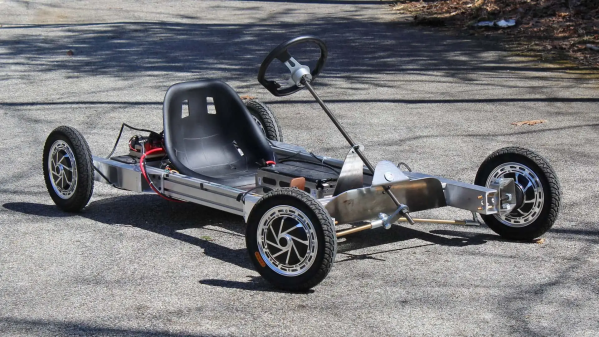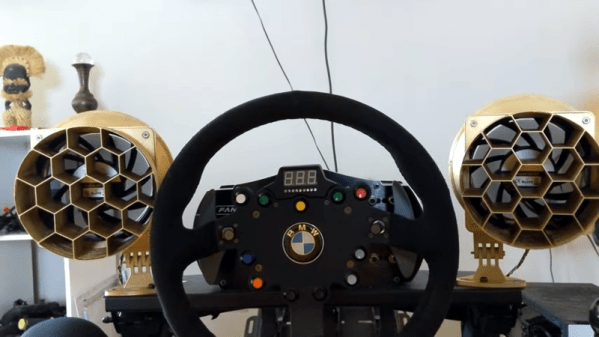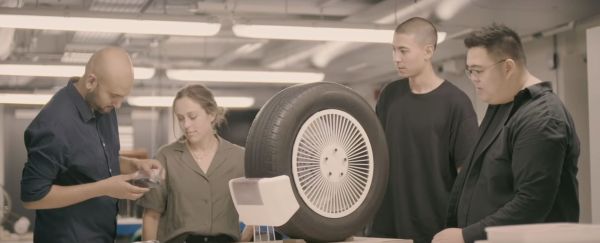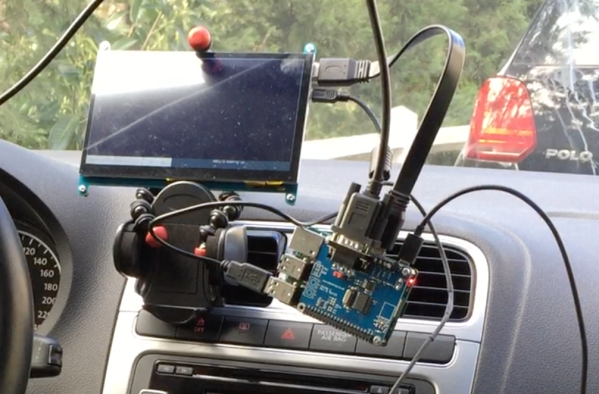It’s been a while since we’ve dunked on an autonomous taxi foul-up, mainly because it seemed for a while there that most of the companies field testing driverless ride-sharing services had either ceased operation or curtailed them significantly. But that appears not to be the case after a Waymo robotaxi got stuck in a Chick-fil-A drive-through. The incident occurred at the chicken giant’s Santa Monica, California location at about 9:30 at night, when the autonomous Jaguar got stuck after dropping off a passenger in the parking lot. The car apparently tried to use the drive-through lane to execute a multi-point turn but ended up across the entrance, blocking other vehicles seeking their late-evening chicken fix. The drive-through-only restaurant ended up closing for a short time while Waymo figured out how to get the vehicle moving again.
driving14 Articles
DIY Quad-Motor Go-Kart Is A Thrilling Ride
[Peter Holderith] set out some time ago to build an electric go-kart. That by itself is not terribly unusual, but where his project diverts from the usual is in the fact that each of the four wheels has an integrated hub motor.
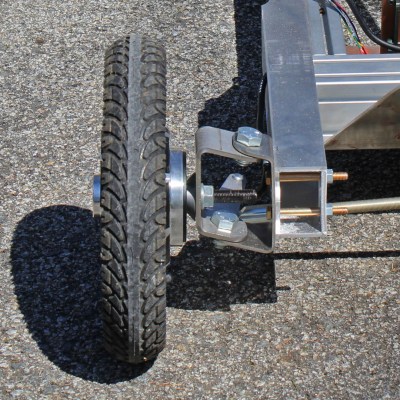
This kart project is a bit of a work in progress, with [Peter] previously building (then scrapping) a failed attempt at a cheap suspension system. But it’s completely operational with all four wheels able to deliver a monstrous amount of power despite being limited by the power supply (a battery pack salvaged from an Audi Q5 Hybrid).
The kart might not look it, but it weighs 177 pounds (80 kg) with the battery and motors accounting for nearly half of that. What is is like to drive? “Nothing short of thrilling,” says [Peter]. It’s got no suspension and is pretty bare bones, not to mention limited in power by the battery, but [Peter] finds it a satisfying drive that nevertheless delivers car-like cues in the driving experience. The build isn’t done, and [Peter] plans to see if more power is available by switching battery chemistries rather than add more battery weight.
Building and driving electric vehicles can be remarkably satisfying, and it’s an area in which hobbyists can meaningfully innovate. Self-balancing one-wheeled vehicles for example look like a ton of fun. Heck, researchers have discovered that even rats seem to enjoy driving just for the fun of it.
Fans Add Reality To Virtual Driving
A few decades ago you might have been satisfied with a crude wireframe flight simulator or driving a race car with the WASD keys. Today, gamers expect more realism, and [600,000 milliliters] is no different. At first, he upgraded his race car driving chair and put on VR goggles. But watching the world whiz by in VR is you can’t feel the wind on your face. Armed with a 3D printer, some software, and some repurposed PC fans, he can now feel the real wind in virtual reality. You can see the build in the video, below.
The electronics are relatively straightforward and there is already software available. The key, though, is the giant 3D printed ducts that direct the airflow. These are big prints, so probably not for some printers, but printers are getting bigger every day. The fan parts are from Thingiverse, but the enclosures are custom and you can download them from the blog post.
Road Pollution Doesn’t Just Come From Exhaust
Alumni from Innovation Design Engineering at Imperial College London and the Royal College of Art want to raise awareness of a road pollution source we rarely consider: tire wear. If you think about it, it is obvious. Our tires wear out, and that has to go somewhere, but what surprises us is how fast it happens. Single-use plastic is the most significant source of oceanic pollution, but tire microplastics are next on the naughty list. The team calls themselves The Tyre Collective, and they’re working on a device to collect tire particles at the source.
Continue reading “Road Pollution Doesn’t Just Come From Exhaust”
Steering By Touch And Haptic Feedback
Scribble is a haptic interface lets you draw your way through traffic. In an environment where fully automated vehicles are becoming the expectation for the next step in transportation, Scribble provides a friendly alternative that allows you to guide your car around, while the automation makes decisions on how to actually steer the car around obstacles.
The driver is guided by haptic feedback that alerts them about the road conditions or obstacles ahead. The project was conceived by [Felix Ros] for his master’s thesis at Eindhoven University, featured a five bar linkage that moves with two lateral degrees of freedom, commonly used for drawing robots.
The code run on an Arduino DUE control over serial by a program made in Open Frameworks that communicates with a Unity 3D driving simulator over UDP. Fellow graduate student [Frank van Valeknhoef]’s Haptic Engines are used as the actuators, outputting the position and a variable force.
The forward kinematics algorithms were based on a clock and weather plotter by SAP, sharing the same servo and drawing arm assembly. The left and right actuators update based on the desired angle, calculating the proper angles needed to achieve the correct position.
While automated vehicles may be able to travel efficiently from one destination to the next, they can’t necessarily wander off course to explore new places. Scribble takes back some of that freedom and allows drivers to decide for themselves where they want to be. It’s an interesting take at inserting the human back into the driver’s seat in automated cars.
Adaptive Infotainment Plays Tunes To Match Your Dangerous Driving
Part of the fun of watching action movies is imagining yourself as the main character, always going on exciting adventures and, of course, being accompanied by the perfect soundtrack to score the excitement and drama of your life. While having an orchestra follow you around might not always be practical, [P1kachu] at least figured out how to get some musical orchestration to sync up with how he drives his car, Fast-and-Furious style.
The idea is pretty straightforward: when [P1kachu] drives his car calmly and slowly, the music that the infotainment system plays is cool and reserved. But when he drops the hammer, the music changes to something more aggressive and in line with the new driving style. While first iterations of his project used the CAN bus, he moved to Japan and bought an old Subaru that doesn’t have CAN. The new project works on something similar called Subaru Select Monitor v1 (SSM1), but still gets the job done pretty well.
The hardware uses an Asus Tinkerboard and a Raspberry Pi with the 7″ screen, and a shield that can interface with CAN (and later with SSM1). The new music is selected by sensing pedal position, allowing him to more easily trigger the aggressive mode that his previous iterations did. Those were done using vehicle speed as a trigger, which proved to be ineffective at producing the desired results. Of course, there are many other things that you can do with CAN bus besides switching up the music in your car.
Continue reading “Adaptive Infotainment Plays Tunes To Match Your Dangerous Driving”
What Makes A Hacker
I think I can sum up the difference between those of us who regularly visit Hackaday and the world of non-hackers. As a case study, here is a story about how necessity is the mother of invention and the people who invent.
Hackaday has overlap with sites like Pinterest and Instructables but there is one vital difference, we choose to create something new and beautiful with the materials at hand. Often these tools and techniques are very simple. We look to make things elegant by reducing the unnecessary clutter, not adding glitter. If something could be built with a 555 timer we will let you know. If there is a better choice for a processor, we will tell you.
My first real work commute was a forty-minute eastward drive every morning and a forty-minute westward drive every evening. This route pointed my car directly into the sun twice a day. Staring into a miasma of incandescent plasma for an hour and a half a day isn’t fun, and probably isn’t safe, but we can fix that.


